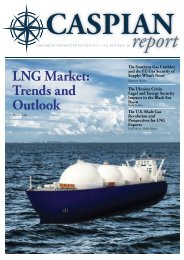Caspian Report - Issue: 07 - Spring 2014
Create successful ePaper yourself
Turn your PDF publications into a flip-book with our unique Google optimized e-Paper software.
Radu Dudau<br />
94<br />
countries pay for Russian gas are,<br />
on average, 15% higher than those<br />
charged to Western European consumers.<br />
According to Izvestia (Jan.<br />
2013), the average price of Russian<br />
gas as sold to Romania during the<br />
first half of 2012 was $431.8/thousand<br />
cubic meters (tcm), compared<br />
with $379.3/tcm in Germany.<br />
The East European gas market is quasimonopolistic,<br />
dominated by Gazprom’s<br />
supply and infrastructure. The prices<br />
that East European countries pay for<br />
Russian gas are, on average, 15% higher<br />
than those charged to Western European<br />
consumers.<br />
From a geological viewpoint, natural<br />
gas is the main potential line of<br />
development in the Black Sea Basin.<br />
To maximise this potential, Romania<br />
has three strategic options:<br />
(a) to increase the productivity of<br />
mature conventional wells through<br />
new extraction technologies; (b) to<br />
develop new finds in the continental<br />
Black Sea shelf; (c) to explore<br />
and develop the country’s shale gas<br />
reserves.<br />
Let us examine them in turn.<br />
Domestic strategic options<br />
Enhanced Productivity of Mature<br />
Wells<br />
Romania’s hydrocarbon reserves<br />
are fragmented and “old,” and well<br />
productivity is among the lowest in<br />
Europe. In order to halt productivity<br />
decline, massive investments are<br />
needed to improve extraction technologies<br />
(increase of reservoir pressure,<br />
stimulation, deep drilling, etc).<br />
OMV Petrom has undertaken an extensive<br />
investment program of this<br />
kind, and managed in 2013 to halt<br />
production decline and even obtain<br />
a slight increase in crude oil production<br />
as compared to 2012. It has begun<br />
the extensive redevelopment of<br />
seven onshore oil fields, including<br />
drilling new wells and modernising<br />
production facilities. To explore<br />
new fields deep underground, the<br />
company has partnered with Hunt<br />
Oil and Repsol.<br />
Similarly, in 2012, the country’s<br />
largest natural gas producer, stateowned<br />
Romgaz, recorded a marginal<br />
production increase compared<br />
with the previous year. Nevertheless,<br />
there remains an urgent need for<br />
human and financial capital in this<br />
field, and the results of this can only<br />
be gradual and long-term.<br />
Offshore reserves<br />
In February 2012, Exxon Mobil &<br />
OMV Petrom’s Domino-1 well discovered<br />
a deepwater gas deposit of<br />
up to 100 bcm in the Neptun block<br />
of Romania’s Exclusive Economic<br />
Zone (EEZ). After several “dry” exploratory<br />
drillings in Turkish waters,<br />
this discovery was a remarkable<br />
success.<br />
But despite all of its promise, the<br />
Romanian offshore area is still filled<br />
with uncertainty and difficulties.<br />
First, the discovery of additional reserves<br />
is needed in order to justify<br />
production investment decisions.<br />
A couple of new exploratory deep-










